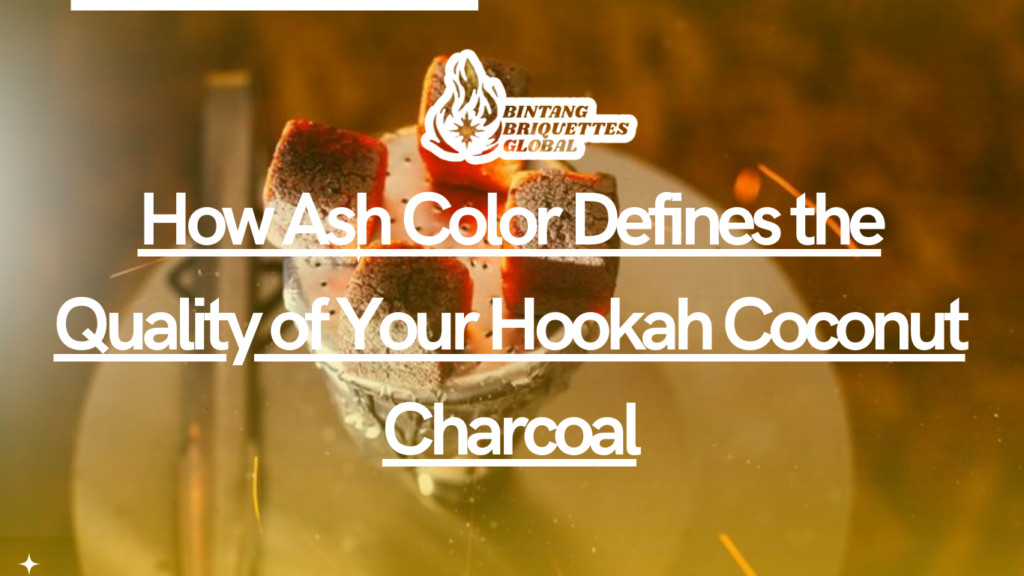bintangbriquettes.com – In the world of premium hookah smoking, one detail often overlooked is the color of ash produced by coconut charcoal briquettes. While many focus on burn time, odor, and shape, ash color can reveal critical information about the charcoal’s purity, production process, and performance. This article will delve deep into how ash color influences the quality of your hookah coconut charcoal, helping users, retailers, and importers make more informed decisions.
Focus Keyphrase: How Ash Color Defines the Quality of Your Hookah Coconut Charcoal
The Basics of Coconut Charcoal for Hookah
1.1 What Is Coconut Charcoal?
Coconut charcoal briquettes are made from the carbonized shells of coconuts—a byproduct of the coconut industry. Unlike wood-based charcoals, they offer cleaner burns, minimal smoke, and are considered an eco-friendlier alternative.
1.2 Why Ash Color and Hookah Coconut Charcoal Quality
- Longer burn time
- No taste interference
- Low ash production
- High heat output
These qualities are essential for a consistent and flavorful shisha experience.
Understanding Ash Formation in Ash Color and Hookah Coconut Charcoal Quality
2.1 What Is Ash in Charcoal?
Ash is the mineral residue left after complete combustion. Its quantity and color depend on:
- Raw material purity
- Carbonization process
- Additives used in briquette shaping
2.2 Natural vs. Chemical Ash
High-quality charcoal will have a natural light-grey to white ash, indicating:
- High carbon content
- Minimal impurities
- Proper carbonization
Charcoal with dark ash often contains:
- Incomplete combustion by-products
- Excess binders
- Inorganic fillers
The Science Behind Ash Color
3.1 What Affects the Color of Ash?
- Temperature of carbonization: Higher temperatures lead to purer charcoal and lighter ash.
- Moisture content: High moisture can cause inconsistent combustion and darker ash.
- Presence of minerals: Calcium and magnesium tend to produce white ash, while iron can darken it.
3.2 Optimal Conditions for White Ash
- Kiln temperatures above 600°C
- Drying coconut shells to below 10% moisture before charring
- Zero chemical additives in the shaping process
Ash Color and Hookah Coconut Charcoal Quality
4.1 White or Light Grey Ash: Sign of Purity
- Signals efficient carbonization
- Results in less frequent ash cleaning during sessions
- Indicates no chemical additives
4.2 Black or Dark Grey Ash: Red Flag
- Poor carbonization
- Potential use of chemical binders or fillers
- Produces more smoke and odor
- May affect flavor of shisha
Real-World Testing of Ash Color
5.1 How to Test Ash Color at Home
- Light the briquette fully until red hot.
- Allow it to burn in a clean, white dish or foil.
- Observe ash color after full burn.
5.2 Comparing Brands
Brand A (light-grey ash): smooth flavor, no odor, long burn.
Brand B (black ash): bitter smoke taste, frequent ash removal needed.
What Manufacturers Should Know
6.1 Producing Low-Ash, High-Quality Coconut Charcoal
- Use mature, dry coconut shells only
- Avoid chemical binders like borax or starch blends
- Employ controlled, high-temperature kilns
6.2 Communicating Quality to Buyers
- Include ash color indicators in product specs
- Educate distributors about its importance
- Show lab test results if available
How Importers and Buyers Can Evaluate Charcoal
7.1 Ash Color as a Procurement Criteria
Importers in Germany, UAE, or Russia increasingly request:
- White ash charcoal
- Low ash volume per burn
- Neutral smell and taste
7.2 Sample Testing Protocol
- Request 3 briquettes per sample
- Burn test each and document ash color
- Compare across multiple suppliers
Misconceptions About Ash Color
8.1 More Ash Means Better Burn? False.
Actually, more ash = more residue = more cleaning.
8.2 All White Ash Means No Additives? Not Always.
While usually true, some chemical additives can mimic the effect.
The Link Between Ash and Environmental Quality
9.1 Lighter Ash = Cleaner Burn = Less Emission
Light ash indicates high carbon efficiency, meaning fewer emissions during burning.
9.2 Coconut Charcoal as Green Energy
- Renewable resource
- No tree cutting involved
- Biodegradable ash with minimal soil toxicity
Conclusion – Ash Color and Hookah Coconut Charcoal Quality
In the quest for the best hookah experience, the ash color of your coconut charcoal briquettes should never be ignored. It’s not just about appearance—it reflects the quality, performance, and even health implications of your shisha session. A light grey or white ash typically indicates clean-burning, premium-grade charcoal that is free from additives and harmful substances. In contrast, dark or black ash may be a red flag for impurities, poor manufacturing, or incomplete carbonization.
If you’re aiming for a premium hookah session with consistent heat, low odor, and safety guaranteed, then choosing coconut charcoal with the right ash characteristics is a must. Whether you’re a casual smoker or a lounge owner, paying attention to the ash color helps ensure that every puff is smooth, flavorful, and toxin-free.


